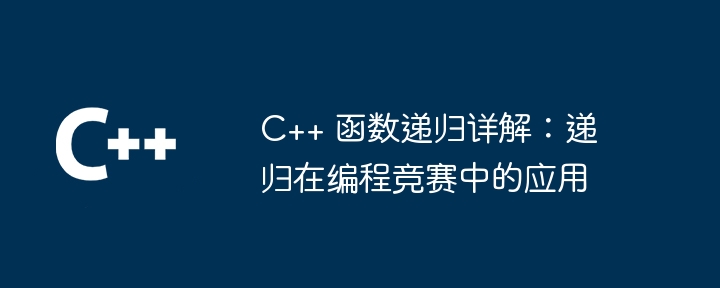 Backend Development
Backend Development
 C++
C++
 Detailed explanation of C++ function recursion: application of recursion in programming competitions
Detailed explanation of C++ function recursion: application of recursion in programming competitions
Detailed explanation of C++ function recursion: application of recursion in programming competitions
May 04, 2024 pm 09:48 PMRecursion is a function self-calling technique that solves a problem based on smaller instances and then combines the results to solve the original problem. Its advantages include code simplicity and the ability to solve self-similar problems, but the disadvantage is that it may lead to stack overflow. Problems such as the Fibonacci sequence can be easily calculated using recursive functions. In programming competitions, recursion is used in problems such as solving mazes, finding shortest paths, and sorting tree structures. For example, the Tower of Hanoi problem can be solved using a recursive function, which involves moving the disks in the tower to another column, one disk at a time.

Detailed explanation of C function recursion: Application of recursion in programming competitions
What is recursion?
Recursion refers to a technique in which a function calls itself. Essentially, it solves a problem in smaller instances and then combines their results to solve the original problem.
Advantages of recursion:
- The code is concise and clear
- Suitable for solving problems with self-similarity
Disadvantages of recursion:
- May cause stack overflow (when the recursion level is too deep)
Syntax of recursion:
returnType functionName(parameters) {
// 递归基准情况,即问题可以被明确解决且无需进一步递归
if (baseCase) {
return result;
}
// 将问题分解成更小的实例
returnType result = functionName(modifiedParameters);
// 根据子问题的解决方案处理原始问题
return processedResult;
}Practical case: Fibonacci sequence
The Fibonacci sequence is a sequence of numbers in which each number is one of the previous two numbers. and. We can use the recursive function to calculate the Fibonacci number at a given index:
int fibonacci(int n) {
if (n == 0) {
return 0;
} else if (n == 1) {
return 1;
} else {
return fibonacci(n - 1) + fibonacci(n - 2);
}
}Application in programming competitions:
Recursion in solving programming competitions Very useful for certain problems, for example:
- Solving a maze
- Finding the shortest path
- Sort tree structure
Example application: Solving the Tower of Hanoi
The Tower of Hanoi problem is a classic recursive problem. The goal is to move all the disks in the tower from one pillar to another, only one move at a time. A disc. We can use a recursive function to solve this problem:
void hanoi(int n, char from, char to, char aux) {
if (n > 0) {
// 将前 n-1 个圆盘移到辅助柱子上
hanoi(n - 1, from, aux, to);
// 将第 n 个圆盘移到目标柱子上
printf("Move disk %d from %c to %c\n", n, from, to);
// 将辅助柱子上的前 n-1 个圆盘移到目标柱子上
hanoi(n - 1, aux, to, from);
}
}The above is the detailed content of Detailed explanation of C++ function recursion: application of recursion in programming competitions. For more information, please follow other related articles on the PHP Chinese website!

Hot Article

Hot tools Tags

Hot Article

Hot Article Tags

Notepad++7.3.1
Easy-to-use and free code editor

SublimeText3 Chinese version
Chinese version, very easy to use

Zend Studio 13.0.1
Powerful PHP integrated development environment

Dreamweaver CS6
Visual web development tools

SublimeText3 Mac version
God-level code editing software (SublimeText3)

Hot Topics
 Concurrency-safe design of data structures in C++ concurrent programming?
Jun 05, 2024 am 11:00 AM
Concurrency-safe design of data structures in C++ concurrent programming?
Jun 05, 2024 am 11:00 AM
Concurrency-safe design of data structures in C++ concurrent programming?
 C++ object layout is aligned with memory to optimize memory usage efficiency
Jun 05, 2024 pm 01:02 PM
C++ object layout is aligned with memory to optimize memory usage efficiency
Jun 05, 2024 pm 01:02 PM
C++ object layout is aligned with memory to optimize memory usage efficiency
 How to implement a custom comparator in C++ STL?
Jun 05, 2024 am 11:50 AM
How to implement a custom comparator in C++ STL?
Jun 05, 2024 am 11:50 AM
How to implement a custom comparator in C++ STL?
 How to implement the Strategy Design Pattern in C++?
Jun 06, 2024 pm 04:16 PM
How to implement the Strategy Design Pattern in C++?
Jun 06, 2024 pm 04:16 PM
How to implement the Strategy Design Pattern in C++?
 Similarities and Differences between Golang and C++
Jun 05, 2024 pm 06:12 PM
Similarities and Differences between Golang and C++
Jun 05, 2024 pm 06:12 PM
Similarities and Differences between Golang and C++
 What are the underlying implementation principles of C++ smart pointers?
Jun 05, 2024 pm 01:17 PM
What are the underlying implementation principles of C++ smart pointers?
Jun 05, 2024 pm 01:17 PM
What are the underlying implementation principles of C++ smart pointers?
 How to implement C++ multi-thread programming based on the Actor model?
Jun 05, 2024 am 11:49 AM
How to implement C++ multi-thread programming based on the Actor model?
Jun 05, 2024 am 11:49 AM
How to implement C++ multi-thread programming based on the Actor model?







